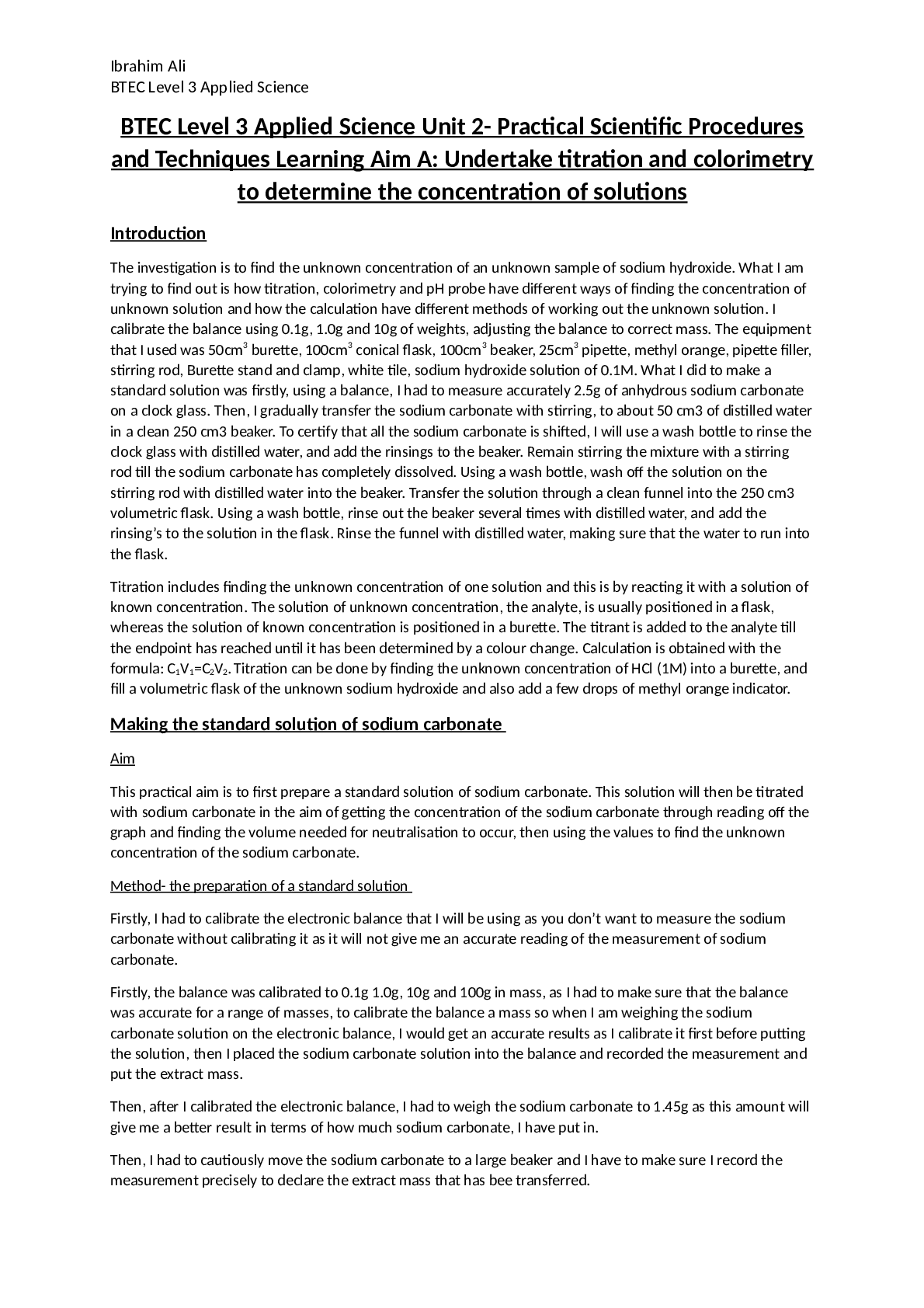Introduction
The investigation is to find the unknown concentration of an unknown sample of sodium hydroxide. What I am
trying to find out is how titration, colorimetry and pH probe have different ways of finding the concentration of
unknown solution and how the calculation have different methods of working out the unknown solution. I
calibrate the balance using 0.1g, 1.0g and 10g of weights, adjusting the balance to correct mass. The equipment
that I used was 50cm3
burette, 100cm3
conical flask, 100cm3
beaker, 25cm3
pipette, methyl orange, pipette filler,
stirring rod, Burette stand and clamp, white tile, sodium hydroxide solution of 0.1M. What I did to make a
standard solution was firstly, using a balance, I had to measure accurately 2.5g of anhydrous sodium carbonate
on a clock glass. Then, I gradually transfer the sodium carbonate with stirring, to about 50 cm3 of distilled water
in a clean 250 cm3 beaker. To certify that all the sodium carbonate is shifted, I will use a wash bottle to rinse the
clock glass with distilled water, and add the rinsings to the beaker. Remain stirring the mixture with a stirring
rod till the sodium carbonate has completely dissolved. Using a wash bottle, wash off the solution on the
stirring rod with distilled water into the beaker. Transfer the solution through a clean funnel into the 250 cm3
volumetric flask. Using a wash bottle, rinse out the beaker several times with distilled water, and add the
rinsing’s to the solution in the flask. Rinse the funnel with distilled water, making sure that the water to run into
the flask.
Titration includes finding the unknown concentration of one solution and this is by reacting it with a solution of
known concentration. The solution of unknown concentration, the analyte, is usually positioned in a flask,
whereas the solution of known concentration is positioned in a burette. The titrant is added to the analyte till
the endpoint has reached until it has been determined by a colour change. Calculation is obtained with the
formula: C1V1=C2V2. Titration can be done by finding the unknown concentration of HCl (1M) into a burette, and
fill a volumetric flask of the unknown sodium hydroxide and also add a few drops of methyl orange indicator.
Making the standard solution of sodium carbonate
Aim
This practical aim is to first prepare a standard solution of sodium carbonate. This solution will then be titrated
with sodium carbonate in the aim of getting the concentration of the sodium carbonate through reading off the
graph and finding the volume needed for neutralisation to occur, then using the values to find the unknown
concentration of the sodium carbonate.
Method- the preparation of a standard solution
Firstly, I had to calibrate the electronic balance that I will be using as you don’t want to measure the sodium
carbonate without calibrating it as it will not give me an accurate reading of the measurement of sodium
carbonate.
Firstly, the balance was calibrated to 0.1g 1.0g, 10g and 100g in mass, as I had to make sure that the balance
was accurate for a range of masses, to calibrate the balance a mass so when I am weighing the sodium
carbonate solution on the electronic balance, I would get an accurate results as I calibrate it first before putting
the solution, then I placed the sodium carbonate solution into the balance and recorded the measurement and
put the extract mass.
Then, after I calibrated the electronic balance, I had to weigh the sodium carbonate to 1.45g as this amount will
give me a better result in terms of how much sodium carbonate, I have put in.
Then, I had to cautiously move the sodium carbonate to a large beaker and I have to make sure I record the
measurement precisely to declare the extract mass that has bee transferred.
Read More


